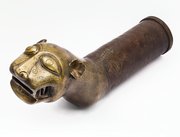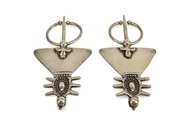
Intaglio Glass Ewer
Museum of Islamic Art
- Title:
- Intaglio Glass Ewer
- Production place:
- Iran
- Date:
- 945 - 1055
- Period:
- Buyid
- Title:
- Intaglio Glass Ewer
- Production place:
- Iran
- Date:
- 945 - 1055
- Period:
- Buyid
- Material:
- Glass
- Technique:
- Glassblowing, Wheel cutting, Applying
- Dimensions:
- 22.7 cm
- Diameter:
- 12.3 cm
Intaglio - the decoration of glass or gemstones via abrasion, rather than cutting - is a laborious process only undertaken by the most masterful artisans. As with many aspects of glass-making and glass-working, the artists of mediaeval Iran continued and expanded upon their pre-Islamic Sasanian traditions in the execution of finely-crafted and elaborately decorated glass vessels. This example, with its gently rounded, pear-shaped body blown in pale blue glass, combines both wheel-cutting and wheel-abrasion in the elaborate decoration which covers nearly its entire surface: rosettes, floral buds, and almond-shaped patterns fill the entire body, ceasing only at the neck and the applied strap handle. A final flourishing element - a vertical, palmette-like spring of vegetation - tops the handle. The closest parallels to this decorative programme are found on the famed contemporary carved rock crystal ewers from Fatimid Egypt. It is possible that this vessel was intended as a beautiful, but less expensive, imitation of such wares from the Eastern Mediterranean.



